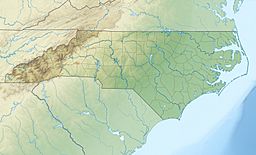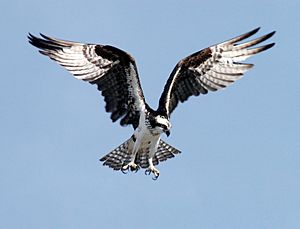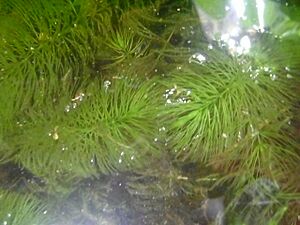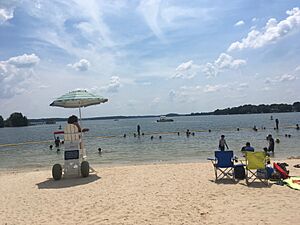Lake Norman facts for kids
Quick facts for kids Lake Norman |
|
|---|---|
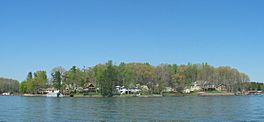
Typical coastline
|
|
| Location | Catawba / Iredell / Lincoln / Mecklenburg counties, North Carolina, United States |
| Coordinates | 35°29′N 80°56′W / 35.483°N 80.933°W |
| Lake type | Reservoir |
| Primary inflows | Catawba River |
| Primary outflows | Catawba River via Cowans Ford Dam |
| Catchment area | 1,790 square miles (4,600 km2) |
| Basin countries | United States |
| Max. length | 33.6 miles (54.1 km) |
| Max. width | 9 miles (14 km) |
| Surface area | 32,510 acres 50.80 sq mi (132 km2) |
| Average depth | 33.5 feet (10.2 m) |
| Max. depth | 112 feet (34 m) |
| Water volume | 1,093,600 acre-feet (1,348,900,000 m³) |
| Residence time | 207 days |
| Shore length1 | 520 miles (840 km) |
| Surface elevation | 760 feet (230 m) |
| Islands | Many (Near 60) |
| Settlements | Lake Norman of Catawba, Davidson, Cornelius, Westport |
| 1 Shore length is not a well-defined measure. | |
Lake Norman is the biggest man-made lake in North Carolina. It was built between 1959 and 1964. This huge lake was created when the Cowans Ford Dam was built by Duke Energy. Lake Norman is located in Iredell County, about 40 miles north of Charlotte. It's a popular spot, especially for mountain biking at Lake Norman State Park.
Contents
About Lake Norman
Lake Norman gets its water from the Catawba River. The water then flows into Mountain Island Lake to the south. The lake was named after Norman Atwater Cocke, who used to be the president of Duke Power. People sometimes call Lake Norman the "inland sea" of North Carolina. It has a shoreline of 520 miles (840 km) and covers more than 50 square miles (130 km2). The lake's surface is 760 feet (230 m) above sea level when full. You can cross Lake Norman on Interstate 77 and North Carolina Highway 150.
How Lake Norman Makes Electricity
Lake Norman helps provide electricity to the Piedmont area of the Carolinas. Its water powers the generators at the hydroelectric station at Cowans Ford Dam. It also helps cool the Marshall Steam Station (a coal-fired power plant) and the McGuire Nuclear Station. These stations use the lake water to cool their reactors. The lake also supplies drinking water to many towns. These include Lincoln County, Catawba County, Iredell County, Charlotte, and other towns in Mecklenburg County. Some of these towns are Cornelius, Davidson, and Huntersville.
Nature and Environment
Climate Around Lake Norman
Lake Norman has a humid subtropical climate. This means it has warm to hot summers and cool to mild winters. Rain can happen any time of year. Lake Norman gets about 43.1 inches (1,090 mm) of rain each year. It also gets about 2 inches (51 mm) of snow. February usually has the strongest winds, and August has the calmest.
The lake touches four counties: Catawba, Iredell, Mecklenburg, and Lincoln. July is usually the warmest month. The average high temperature is 90 °F (32 °C), and the average low is 70 °F (21 °C). January is the coolest month. The average high is 51 °F (11 °C), and the average low is 29 °F (−2 °C). The hottest temperature ever recorded was 107 °F (42 °C) in 1954. The coldest was −5 °F (−21 °C) in 1985.
| Climate data for Lake Norman, North Carolina (elevation 760 feet (230 m)) | |||||||||||||
|---|---|---|---|---|---|---|---|---|---|---|---|---|---|
| Month | Jan | Feb | Mar | Apr | May | Jun | Jul | Aug | Sep | Oct | Nov | Dec | Year |
| Record high °F (°C) | 79 (26) |
81 (27) |
88 (31) |
92 (33) |
99 (37) |
107 (42) |
106 (41) |
104 (40) |
101 (38) |
95 (35) |
85 (29) |
80 (27) |
107 (42) |
| Mean daily maximum °F (°C) | 51 (11) |
56 (13) |
64 (18) |
72 (22) |
80 (27) |
87 (31) |
90 (32) |
88 (31) |
82 (28) |
73 (23) |
63 (17) |
54 (12) |
90 (32) |
| Mean daily minimum °F (°C) | 29 (−2) |
32 (0) |
39 (4) |
48 (9) |
57 (14) |
66 (19) |
70 (21) |
68 (20) |
62 (17) |
49 (9) |
40 (4) |
32 (0) |
29 (−2) |
| Record low °F (°C) | −5 (−21) |
−4 (−20) |
−1 (−18) |
25 (−4) |
31 (−1) |
40 (4) |
54 (12) |
49 (9) |
34 (1) |
25 (−4) |
11 (−12) |
3 (−16) |
−5 (−21) |
| Average precipitation inches (mm) | 3.85 (98) |
3.66 (93) |
3.71 (94) |
2.85 (72) |
2.99 (76) |
3.99 (101) |
3.48 (88) |
4.45 (113) |
3.66 (93) |
3.86 (98) |
3.06 (78) |
3.54 (90) |
43.1 (1,090) |
| Source: The Weather Channel | |||||||||||||
Geology of Lake Norman

Lake Norman is a man-made lake. It is 33.6 miles (54.1 km) long and 9 miles (14 km) wide. It has 520 miles (840 km) of shoreline. The lake's average depth is 33.5 feet (10.2 m), but it can reach 110 feet (34 m) deep at its outlet. The lake's bottom is mostly made of clay and plastic soils. These soils are specially built to be strong and stable. Clay soil is good because it sticks together when wet.
Lake Norman sits on two main rock areas: the Charlotte belt and the Inner Piedmont belt. The Charlotte belt has igneous rock that is 300 to 500 million years old. This type of rock is often used in building. The Inner Piedmont belt has older, metamorphic rocks, about 500 to 700 million years old. The lake was built on the Catawba River, which has a type of soil called inceptisols. This soil is found in river floodplains.
Erosion Around the Lake
Erosion is a problem around Lake Norman. This is because many homes are built very close to the lake's edge. Since Lake Norman is popular for fun activities, many people want to live there. Rainwater runoff from paved areas like roads and driveways causes a lot of erosion.
To help prevent erosion, North Carolina has rules. Since 2001, new homes must have a 50-foot buffer zone. This means a strip of natural plants must be kept between the home and the lake. These plants help hold the soil and filter rainwater. Older neighborhoods have a 30-foot buffer zone.
Water Quality in Lake Norman
People are concerned about the water quality in Lake Norman. Duke Energy, the company that built the lake, regularly checks the water. They have permits to release some treated wastewater into the river. However, they must make sure the water they release is as clean as the water they take from the lake.
Past reports from 2007 showed good water quality. One report found that Lake Norman had some of the best water quality among five lakes in the Catawba Chain. Samples showed:
- Low levels of organic nitrogen (a type of nutrient)
- Normal levels of other substances
- Good Secchi depths, which means the water was clear
These reports help researchers keep an eye on the lake's health.
Lake Norman's Wildlife
North Carolina's Piedmont region has many different kinds of plants and animals. Lake Norman is a very important home for birds, fish, mammals, and plants. It is the biggest lake in North Carolina. The area around Lake Norman has different types of forests.
Fish and Other Animals
Fish are a big part of Lake Norman's ecosystem. Many fish were put into the lake by fishing groups. The lake has many different kinds of fish, including:
The striped bass used to be very popular. But their numbers went down, so the state stopped adding them in 2012. Now, spotted bass and hybrid striped-spotted bass are the main sport fish.
Other animals living around Lake Norman include:
- Crayfish
- Dragonfly
- Heelsplitter (a rare freshwater mussel)
Many mammals live in the Lake Norman area. These include:
You can also find reptiles and amphibians around the lake. These include:
Most snakes are harmless. But you should be careful of the venomous Eastern copperhead.
Birds of Lake Norman
Birds are also important to the Lake Norman ecosystem. Many different bird species live here, including birds that migrate (travel) through the area. There are also many shorebirds.
Some birds you might see around Lake Norman are:
Plants Around the Lake
Many native plants grow around Lake Norman. These include various trees and flowering plants.
Some common trees are:
- Silverling (a type of Baccharis plant)
- Hornbeam or ironwood (a type of beech tree)
- Yellow poplar or tulip poplar
- Sassafras
Many flowering plants also grow here:
- Indian mallow
- Baneberry
- White snakeroot (which is poisonous)
- Stork's-bill
Managing the Lake's Environment
Managing Lake Norman is a big job. It's a home for plants and animals, and a place for people to have fun. Many groups work together to protect the lake. Duke Energy owns much of the land under and around the lake. They work with state and county groups, plus other environmental organizations.
One big challenge is managing an invasive species called hydrilla (Hydrilla verticillata). This plant came from India and was first seen in Lake Norman in 2001. Hydrilla can grow very thick, hurting native plants and fish. It can also make some birds sick. The Lake Norman Marine Commission helps control hydrilla by putting grass carp (fish that eat plants) into the lake.
Other efforts focus on helping native animals. For example, the Lake Norman Wildlife Conservationists and Duke Energy work together to create nesting spots for great blue herons and osprey.
History of Lake Norman
Catawba People and the River
Long before Lake Norman was created, the Catawba people lived along the Catawba River for 6,000 years. The river was very important to them. Maps from the 1700s show the Catawba River as a key feature.
As more settlers came, there were conflicts over the land. The Catawba people faced challenges to keep their culture and land. In the 1840 Nations Ford Treaty, they gave up much of their land. Even though the Catawba people were displaced, their history and artifacts remain. Pottery and other items have been found along the riverbanks. Archaeologists continue to find new sites where Native Americans lived. It's likely that more historical items are under the lake today.
Before the Lake Was Built
Building the Cowans Ford Dam and Lake Norman was part of a bigger plan. This plan started in the early 1900s to control the Catawba River. The goal was to prevent floods and droughts, and to make electricity.
In 1900, the Catawba Power Company was formed. Duke Power Company bought it and started building dams. By 1928, the Catawba River system had many dams and powerhouses. It was called "the world's most electrified river." Duke Power had plans for the Cowans Ford Dam since 1904.
In 1957, Duke Power announced plans for the Cowans Ford Lake. Newspapers said it would create a lot of electricity and a new place for water sports. The main reason for the dam was to provide power when electricity use was highest.
Building the lake meant flooding about 30,000 acres of land. Most of this land was timberland and already owned by Duke Power. Duke Power bought land from farmers who lived in the area. They also had to clear trees and homes from the land before it was flooded. Some families moved their houses to higher ground.
The project started in 1959. The dam was finished in 1962, and the lake began to fill. Farms, mills, and even historic sites like the Revolutionary War Battle of Cowan's Ford battlefield were covered by the water. Some mill towns closed down. Cemeteries were also moved to new locations.
Duke Power also worked with North Carolina to create Lake Norman State Park. They built fishing areas and boat ramps for public use.
Naming the Lake
Lake Norman was named after Norman Atwater Cocke. He was the president of Duke Energy from 1947 to 1959. He helped plan the new lake and worked with local people and state officials. In 1960, Duke Energy decided to name the lake in his honor.
The "Long Sam" Story
In 1957, before the lake was finished, two reporters and a photographer found a young girl named Dorothy Brown near the future lake. They called her "Long Sam" after a popular comic strip character. She became famous for a short time, appearing on TV. Dorothy used the money she earned to get a high school education. This story shows how the lake's development changed the lives of people in the area.
Development of the Lake Area
How the Lake Was Created
Duke Power's plans for Lake Norman started in 1904. They built many dams along the Catawba River to become the main electricity supplier. They bought land along the river to prepare for the flooding. The Cowans Ford site was chosen for the final dam. Duke Power got permission to build the dam in 1957. Construction began in 1959 and finished in 1962. Lake Norman now covers over 33,000 acres.
Rules and Regulations
New rules were needed for Lake Norman. Fishing and boating rules follow the North Carolina Wildlife Resources Commission's guidelines. Some fish species, like blue catfish and striped bass, were introduced to the lake.
Boats with engines over 10 horsepower must be registered. The Lake Norman Safety Commission was formed in 1965 to promote safety on the water. The Lake Norman Commission also sets rules for safety, like speed limits near marinas. Some islands are protected areas for birds like the Blue Heron.
Homes Around the Lake
Since Lake Norman was created, many homes have been built around it. The area is popular because of the lake and its closeness to Charlotte, a large city. In 1963, Duke Energy offered land for lease for cottages. Other developers built neighborhoods. Many homes were vacation homes at first, but more people started living there permanently. Towns like Davidson, Mooresville, and Cornelius grew quickly.
The construction of I-77 in 1975 made it easier to get to Lake Norman. This led to even more growth, with new homes, restaurants, and stores. Today, the counties around Lake Norman are some of the fastest-growing in North Carolina.
I-77 and Transportation
The building of I-77 helped people travel easily through the Lake Norman area. Before the lake, people used smaller roads to get to Charlotte. When Lake Norman was created, it flooded many roads. Duke Power paid North Carolina to move and rebuild roads and bridges.
I-77, completed in 1975, made commuting to Charlotte much faster. This also helped the towns around the lake grow. However, today I-77 near Lake Norman is known for its traffic. To help with this, express lanes are being built to improve travel time.
Airports Near the Lake
Lake Norman has two small airports, Long Island Airpark and Lake Norman Airpark.
Fun Activities at Lake Norman
Duke Energy and Recreation
Duke Energy has helped make Lake Norman a great place for fun. In 1964, they leased land for cabins. As the lake became more popular, more homes and businesses were built. When I-77 was built in the 1970s, it became even easier for people from Charlotte to visit.
Duke Energy has built public fishing spots and boat ramps. They also offer free tours of their facilities. They plan to create even more recreation sites, like campgrounds and picnic areas, over the next 20 years.
Fishing and Hunting
Fishing is very popular at Lake Norman. You can find Striped Bass, Largemouth Bass, Catfish, and Bluegill. Fishing tournaments are held here, and local businesses benefit from anglers.
All the fish in Lake Norman were put there by people since it's a man-made lake. While fishing is popular, hunting for waterfowl (ducks, geese) also happens in the autumn. However, hunting has become less popular due to more buildings around the lake and stricter rules.
Lake Norman State Park
Duke Power Company gave 1,328 acres of land to create Lake Norman State Park in 1962. It's a busy place for outdoor activities. The park has:
- Over 30 miles of mountain biking, hiking, and running trails (Itusi Trail)
- A 5-mile hiking and running trail (Lakeshore Trail)
- A swimming beach open from April to October
- Docks for boating and fishing (free to use)
- A campground with sites for tents and RVs
Many people visit the park each year. In 2017, almost a million people came to enjoy nature. The park has a rich history. It used to be farmland, then pine forests grew. Now, hardwood trees like Hickory are common. The park is home to many animals, including deer, squirrels, coyotes, frogs, turtles, and various birds like hawks and wild turkeys.
Davidson College Lake Campus
Davidson College has a lake campus thanks to a donation of land from Duke Energy in 1959. This campus has been used for college events and activities. Over the years, the rules for the lake campus became stricter.
Counties Around Lake Norman
Towns and Communities
- Cornelius
- Davidson
- Denver
- Governors Island
- Huntersville
- Lake Norman of Catawba
- Lake Norman of Iredell
- Mooresville
- Sherrills Ford
- Terrell
- Troutman
- Westport


